

The Gemini project culminated in the construction of two 8-meter, infrared-optimized telescopes spanning both hemispheres and the whole sky. However you slice it, the Gemini project also spanned both of Earth's hemispheres, as a partnership involving the USA, UK, Canada, Australia, Argentina, Chile, and Brazil. Gemini-North, in the only place where an 8-meter telescope rates as only the fourth largest optical/IR instrument on-site, was recently renamed in honor of the late Fred Gillette, who played an indispensible role in the entire planning and construction stages.
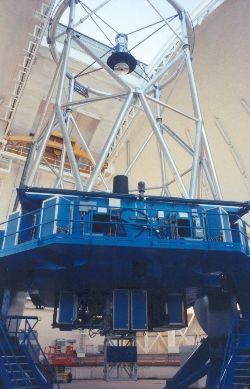

The Gemini instrument complement is still growing, delayed by a crisis involving the near-IR spectrograph and loss of a multiobject spectrograph with the destruction of Australia's Mt. Stromlo Observatory in a wildfire. It does have several very powerful instruments already, particularly GMOS, the Gemini Multi-Object Spectrometer, and the first generally usable AO system available to the whole US community. As part of a team including Ian Smail, Frazer Owen, and inside spy Mike Ledlow, I've actually gotten my hands on GMOS data for high-redshift candidates behind a couple of galaxy clusters (where we had very deep optical and radio data to selectr and understand the candidates). This is sort of funny, considering the nuisance I made of myself for several years about whether Gemini would be a net gain for the US community if it caused closure of the facilities elsewhere, especially Kitt Peak, to pay its upkeep. The jury's still out - I may yet owe Todd Boroson a public apology.
Setting up a multiobject observation can be tedious. One starts with an acquisition image taken by GMOS acting as a camera, using it to define the object locations on a consistent internal system (distortions and everything) to fabricate the slit masks. One may try numerous potential rotation settings to maximize the number of interesting targets that can be observed without their spectra overlapping. If we don't mess this up, we end up with a set of short-slit spectra of our faint targets.
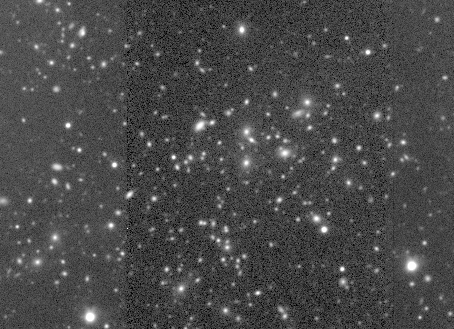 The process starts with a 2Kx3K acquisition image, like this
one of Abell 851 in the I band. Even when adaptive optics are
not in use, the Gemini system pays a lot of attention to the
wavefront and image quality, keeping the optical train actively
aligned and focused. This stack of 3 images, taken in pretty mediocre
conditions since it's not actually supposed to be science-grade,
has 1.1" FWHM. Numerous galaxies show up in the "foreground" cluster
at z=0.4, among the richest known.
The process starts with a 2Kx3K acquisition image, like this
one of Abell 851 in the I band. Even when adaptive optics are
not in use, the Gemini system pays a lot of attention to the
wavefront and image quality, keeping the optical train actively
aligned and focused. This stack of 3 images, taken in pretty mediocre
conditions since it's not actually supposed to be science-grade,
has 1.1" FWHM. Numerous galaxies show up in the "foreground" cluster
at z=0.4, among the richest known.
 Here's one of Mike's setups for Abell 851, using the Gemini software
tools. Note how the whole projected spectrum for each slit position
is shown so you can check for overlaps with something else that
ought to be observed as well.
Here's one of Mike's setups for Abell 851, using the Gemini software
tools. Note how the whole projected spectrum for each slit position
is shown so you can check for overlaps with something else that
ought to be observed as well.
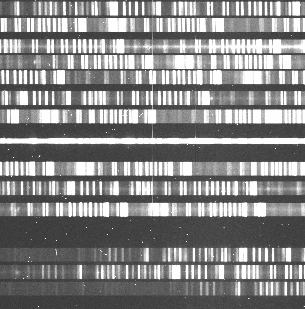 And now to the real data.
GMOS places short slits across the objects
of interest, so you get over 200 independent spectra (if you have useful
things to do with that many in one field). Reduction involves a heavy
dose of sheer bookkeeping. Here are some spectra in the blue, with
a few showing emission lines even before subtracting night-sky airglow
that produces the lines running all along each slit.
And now to the real data.
GMOS places short slits across the objects
of interest, so you get over 200 independent spectra (if you have useful
things to do with that many in one field). Reduction involves a heavy
dose of sheer bookkeeping. Here are some spectra in the blue, with
a few showing emission lines even before subtracting night-sky airglow
that produces the lines running all along each slit.
One especially interesting result of our initial spectra was detecting a galaxy previously found as a bright submillimeter source, revealed as an active galaxy at redshift z=3.35. This plot shows data from red and blue grating settings, with strong emission lines of hydrogen, nitrogen, and carbon with ratios characteristic of active nuclei rather than starbursts.
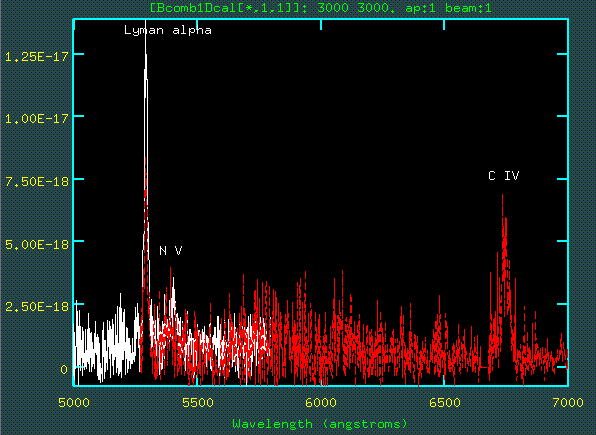
Some of the same crew have also used IR images from Gemini-South to complement HST images of the spiral galaxy hosting the double radio source 0313-192. Here are JHK images from the FLAMINGOS system, with image quality 0.36-0.40 arcsec FWHM:
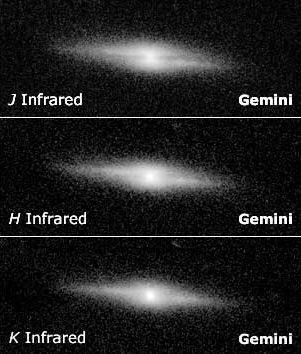
Last changes: 5/2003 © 2003